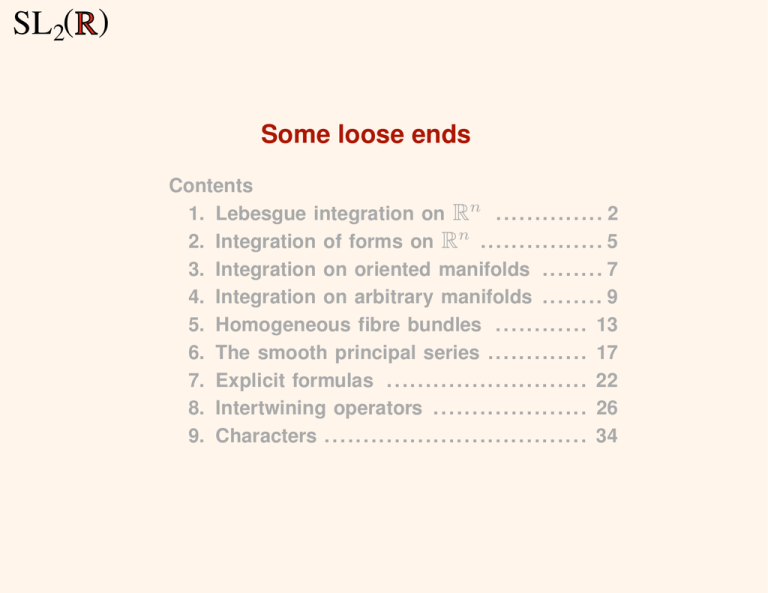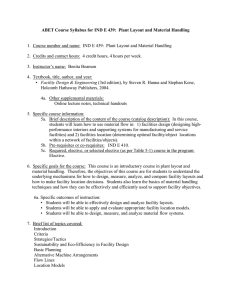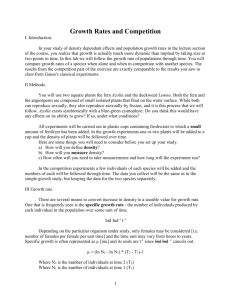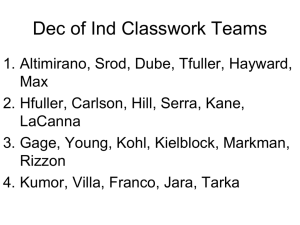( ) SL Some loose ends 2
advertisement

SL2( )
Some loose ends
Contents
1. Lebesgue integration on Rn . . . . . . . . . . . . . . 2
2. Integration of forms on Rn . . . . . . . . . . . . . . . . 5
3. Integration on oriented manifolds . . . . . . . . 7
4. Integration on arbitrary manifolds . . . . . . . . 9
5. Homogeneous fibre bundles . . . . . . . . . . . . 13
6. The smooth principal series . . . . . . . . . . . . . 17
7. Explicit formulas . . . . . . . . . . . . . . . . . . . . . . . . . . 22
8. Intertwining operators . . . . . . . . . . . . . . . . . . . . 26
9. Characters . . . . . . . . . . . . . . . . . . . . . . . . . . . . . . . . . . 34
1. Lebesgue integration on Rn
2
If f (x1 , . . . , xn ) is a smooth function on Rn with support in the
open set X , its integral is
!
f (x) dx1 . . . dxn ,
X
which can be explicitly calculated (rarely) by reducing it to onedimensional integrals, where one can apply the fundamental theorem of calculus. If we make a change of variables x = h(y)
where h is an invertible smooth function the integral becomes
!
h−1 (X)
"
#
f h(y) |∂x/∂y| dy
since x ∈ X if and only if y = h−1 (x) lies in h−1 (X). What is
important here is that this formula involves the absolute value of
the Jacobian determinant.
3
The change of variables formula in 1D might seem a bit paradoxical but it agrees with the usual rules of calculus. For example
!
∞
−∞
f (x) dx = −
!
−∞
f (−y) dy =
∞
!
∞
f (−y) dy
−∞
The point is that this integral represents an integral of a measure.
4
2. Integration of forms on Rn
5
If ω is an n-form on Rn it can be written as f (x) dx1 ∧ . . . ∧ dxn
and then its integral is
!
ω=
Rn
!
f (x) dx1 . . . dxn
Rn
The point is that we have to first arrange the formula for ω so as
to match the standard orientation of Rn .
6
3. Integration on oriented manifolds
7
Suppose M to be an oriented manifold. We can cover it by coordinate patches Ui embedded in Rn in such a way that the orientations all match that of M , and we can find a partition of unity
ϕi subordinate to this covering. Then ϕi ω may be identified with
a compactly supported form ωi on Rn and
!
8
ω=
M
$!
i
ωi .
Ui
4. Integration on arbitrary manifolds
9
Suppose now that M is an arbitrary manifold of dimension n.
At each point m of M we have the one-dimensional real vector
%n
&
space
T%
x . The fibre bundle M of orientations on M is the
n
quotient of
Tx − {0} by the positive real numbers, a set of
& is a two-fold covering of M . The
two elements. The space M
manifold M is orientable if and only if this bundle has a section,
which is to say that at each point we have a continuous choice
of orientation. If it is orientable then we can integrate forms over
M , but only after making a choice of orientation. Reversing the
orientation will change the sign of the integral. So there is no
canonical way to integrate forms on M .
There is, however, a canonical way to integrate something else,
called a density or twisted n-form.
10
& has a conical involution, interchanging orientaThe covering M
tions at any point of M . The n-forms on M may be identified
with forms on M that are invariant under this involution. Since
changing orientation changes the sign of an integral of a form,
& is 0. A twisted n form on M is
the integral of such a form on M
& that is taken to its negative by the
defined to be an n-form on M
& then by definition
involution. If ω
' is such a form on M
!
1
ω
'=
2
M
!
'
M
ω
'
In other words, what is invariantly defined on an arbitrary manifold is the integral of a twisted n-form.
11
The twisted n-forms on a manifold are sections of a one-dimensional
fibre bundle on M . The fibre at x is the space of all maps f
%n
from
Tx to R such that
f (cv) = |c|f (v)
On any manifold there always exists at least one twisted n-form
that never vanishes.
12
5. Homogeneous fibre bundles
13
Suppose now that G is a Lie group and H a closed subgroup.
If (σ, U ) is a finite-dimensional representation of H , thne there
is associated to it a fibre bundle over H\G whos e fibre at any
point is non-canonically equal to U . Geometrically it is the quotient of U × G by the group H taking (u, g) to (σ(h)u, hg). The
sections of this bundle over H\G are the functions
f : G −→ U
such that f (hg) = σ(h)f (g) for all h in H and g in G. One
representation of H is that on the tangent space at 1 of H\G,
which may be identified with h\g. The bundle to conjugation Ad
is the tangent bundle. Another is the one dimensional representation of H taking
h −→ | det Adh\g (h)|−1
and the associated bundle is twisted n-forms.
14
Take G = SL2 (R) and H = P . Here p\g = n and the twisted
n-forms correspond to the character
δP :
(
)
a x
&−→ a2
0 1/a
Since a2 > 0 these do not differ from ordinary n-forms. This
remains true for the spaces P1 (Rn ) with n odd, but fails for the
non-orientable cases with n even.
At any rate, a smooth real twisted n-form on P \G may be identified a smooth function f from G to R such that f (pg) = δP (p)f (g).
I write integration of twisted n-forms as
!
ω
P \G
Since G = P K , the quotient P \G may be identified with K ∩
P \K , and if we assign K a total measure 1 integration on P \G
may be identified with integration over K .
15
There is another way to put this. If f is a smooth function of
compact support on G, then
f (g) =
!
f (pg) d! p
P
is a density on P \G—f (pg) = δP (p)f (g). Then with suitable
normalizations
!
f (g) dg =
G
!
f (x)
P \G
!
!
dk
f (pk) d! p
=
!P
!
!K
dk
δP (a)−1 da
f (nak) dn
=
K
A
N
since the integral with respect to d! P can also be expressed as
!
16
δP (a)−1 da
A
!
f (na) dn .
N
There is another formula for integration over P \G. The set P N
is open in G, and the integral
!
f (n) dn
N
converges. It is, up to a constant, another valid formula. If we
identify N with R, what is the constant?
17
6. The smooth principal series
18
Any character (continuous homomorphism into C× ) of A is of
the form
(
)
χs,m :
x 0
&−→ |x|s sgnm (x)
0 1/x
for some s in C and m = 0, 1. This will be a unitary character if
and only if s = it for some real number t.
Any character of A determines one of P since P/N = A. Any
continuous irreducible representation of P is of this form (in particular trivial on N ). In any continuous finite-dimensional representation of P the subgroup N is taken to unipotent matrices.
The principal series representations of G are those induced from
characters of P .
19
Ind∞ (χ | P, G)
1/2
= {f ∈ C ∞ (G, C) | f (pg) = δP χ(p)f (g) for all p ∈ P, g ∈ G}
The group G acts by the right regular action:
Rg f (x) = f (xg)
−1/2
) = C ∞ (P \G)
+1/2
) = Ω∞ (P \G)
• Ind∞ (δP
• Ind∞ (δP
• Ind∞ (χ−1 ) = the dual of Ind∞ (χ)
!
f (x)ϕ(x) dx
(f, ϕ) =
P \G
20
• Ind∞ (χ) is unitary if χ is.
The best way to picture Ind
K.
∞
(χ) is to describe its restriction to
Restricting f to K determines a map from K to C such that
f (pk) = χ(p)f (k)
for all p in P ∩ K . Because G = P K this is an isomorphism.
Since P ∩ K = ±I and χ(−I) = (−1)m :
∞
Ind (χ) |K =
$
*
n≡m mod 2
εn
,
where + means a topological sum (C ∞ Fourier series).
21
Let
ϕn (pk) = δ 1/2 χ(p)εn (k)
If
g=
(
a b
c d
)
then g = pk where
(
)
1/r (ac + bd)/r
(r = c2 + d2 )
p=
0
r
)
(
γ −σ
(γ = d/r, σ = c/r)
k=
σ
γ
Therefore
ϕn (g) = δ 1/2 χ(1/r)(γ + i σ)n
22
7. Explicit formulas
23
The Lie algebra g acts on the subspace of finite sums of the ϕn .
Recall the basis of the complex Lie algebra
(
)
0 −1
κ=
1
0
(
)
1 −i
x+ =
−i
0
)
(
1
i
x− =
i
0
so that
[κ, x± ] = ±2i x±
κ ϕn = ni ϕn
κ(x± ϕn ) = x± (κϕn ) ± 2ix± ϕn
= (n ± 2)i (x± ϕn )
x± ϕn = constant · ϕn±2
24
x± ϕn = constant · ϕn±2
What is the constant? Since εn (1) = 1
x± ϕn (1) = constant
Here the Lie algebra acts on the right. So we use the basic trick
(seen before).
RX f (g) = LgXg−1 f (g)
here with g = 1. Since
x± = α ∓ i(κ + 2ν+ )
Rx± εn (1) = [Lα∓2iν+ ∓ Riκ ]εn (1)
= (s + 1 ± n)
25
Summary:
κ εn = ni εn
x± εn = (s + 1 ± n)εn
We have seen this before when s = −1 and s + 1 = 0 (except for
some small change of sign) caused by a difference between left
and right actions. The space of Harmonic functions is isomorphic
to Ind(δ −1/2 ). More generally:
Every irreducible (g, K)-representation can be embedded
into a principal series representation.
To be proven in a later lecture.
26
8. Intertwining operators
27
Some principal series are isomorphic to other principal series.
Some principal series are reducible. To figure out what’s going
on, we need to calculate the G-covariant (or (g, K)-covariant)
maps from one principal series to another.
The start is a version of Frobenius reciprocity. I recall what this
says for a finite group. Let H be a subgroup of another group G.
If σ is an irreducible representation of H , we want to know how
often an irreducible representation π of G occurs in the representation I(σ) induced by σ . The answer is that π occurs as often
in I(σ) as σ occurs in the restriction of π to H :
"
#
dim HomG π, I(σ) = dim HomH (σ, π)
But since represenations of finite groups always decompose
completely, this is also
dim HomH (π, σ)
28
Theorem. (Frobenius reciprocity for finite groups) Suppose H ⊆
G are finite groups. If (σ, U ) is any finite dimensional representation of H and (π, V ) is one of G then there is a canonical
isomorphism
HomG (π, I(σ)) ∼
= HomH (π, σ)
I(σ) = {f : G → U |f (hg) = σ(h)}
"
#
Either side determines the other—FG (v) = FH π(g)v .
29
Let
Λ1 : Ind∞ (χ) −→ C,
f &−→ f (1)
Theorem. (Frobenius reciprocity for principal series) If V is a
smooth representation of G then composition with Λ1 induces
an isomorphism
"
#
∞
Hom V, Ind (χ | P, G) = HomP (V, δ 1/2 χ)
The Lie algebra n acts trivially on C, so any P -map from V to
δ 1/2 χ takes ν+ v to 0. It must annihilate the subspace nV of V
spanned all the ν+ v . In other words it must factor through the
quotient V /nV , on which A acts. So a new version of the theorem is
"
30
#
Hom V, Ind (χ | P, G) = HomA (V /nV, δ 1/2 χ)
#
" −1 −1/2
.
, V [n]
= HomA χ δ
∞
There are two kinds of N -invariant functionals on Ind (χ), corresponding to the two components in the Bruhat decomposition
∞
G = P ∪ P wN
Formally, we have the integral
Λw (f ) =
!
f (wn) dn
N
which satisfies
Λw (Rn∗ f ) =
= Λw (f )
...
31
!
f (wnn∗ ) dn
N
. . . and then
Λw (Ra f ) =
=
!
!N
!N
f (wna) dn
f (wa · a−1 na) dn
f (waw−1 · w · a−1 na) dn
N
!
f (w · a−1 na) dn
= δ 1/2 χ(a−1 )
N
!
f (wn) dn
= δ −1/2 (a)χ−1 (a) · δ(a)
=
N
= δ 1/2 (a)χ−1 (a)Λw (f )
giving rise to a G-homomorphism
Tw : Ind∞ (χ) −→ Ind∞ (χ−1 )
32
When is the integral
Λw (f ) =
!
f (wn) dn =
N
!
f (wnx ) dx
R
/
(
1 x
nx =
1
)0
defined? Since
√
√
)( √
)
2
2
2
1/ x + 1 √ · · ·
x/√ x + 1 −1/ √x + 1
wnx =
x2 + 1
x/ x2 + 1
1/ x2 + 1
(
f (wnx ) = (x2 + 1)−(s+1)/2 f (kx )
and
Λw (f ) =
!
(x2 + 1)−(s+1)/2 f (kx ) dx
R
Since (x2 + 1)−(s+1)/2 ∼ 1/xs+1 this converges and is holomorphic for RE (s) > 0.
33
Explicitly
"1# "s#
Γ 2 Γ 2
2
−(s+1)/2
" s+1 #
Λw (ϕ0 ) = (x + 1)
dx =
Γ 2
R
!
since ϕ0 (kx ) = 1. This continues meromorphically to all of C.
Similarly
" 1 # " s+1 #
Λw (ϕ1 ) =
Γ
2
Γ
Γ
" s+2 #2
2
Since x± commutes with Tw and x± · εn = (s + 1 ± n)εn we see
that Λw is meromorphic on all of Ind(χ).
In fact it is meromorphic on all of Ind
checking that.
34
∞
(χ), but we’ll postpone
9. Characters
35
If (π, V ) is any smooth representation of G and f lies in Cc∞ (G)
then
!
[π(f )](v) =
f (g)π(g)v dg
G
defines V as a module over Cc∞ (G). This is an element of the
vector space of continuous linear maps from V to itself.
. ⊗ V , and π(f )
If V has finite dimension then HomC (V, V ) = V
would be an element of this tensor product. One can introduce
a topological tensor product that allows us to make the same
assertion for a large class of smooth representations, but here I’ll
∞
look at the case of V = Ind (χ | P, G). I shall define π(f ) as
an element of
Ind(χ−1 ⊗ χ | P × P, G × G) ,
.⊗
. V when V is
which is in fact a topological tensor product of V
Ind∞ (χ).
36
For any f in Cc∞ (G) define
fχ (g, h) =
!
−1/2
A
χδP
(a) da
!
f (h−1 nag) dn ,
N
a function on G × G.
Proposition. The function fχ (g, h) lies in
Ind∞ (χ−1 ⊗ χ | P × P, G × G)
37
For example
fχ (n∗ g, h) =
=
=
!
−1/2
!A
!A
A
χδP
−1/2
χδP
−1/2
χδP
(a) da
(a) da
(a) da
!
!N
!N
f (h−1 na · n∗ g) dn
f (h−1 n · an∗ a−1 · ag) dn
f (h−1 nag) dn
N
= fχ (g, h)
and
!
−1/2
!
f (h−1 na · a∗ g) dn
N
!
!A
−1/2
−1
χδP (ba−1
)
db
f
(h
n · bg) dn
=
∗
fχ (a∗ g, h) =
χδP
A
−1 1/2
=χ
38
δ
(a) da
N
(a∗ ) fχ (g, h)
If F lies in Ind (χ−1 ⊗χ | P ×P, G×G) and ϕ in Ind (χ) then
for each fixed h in G the product F (g, h)·ϕ(g) lies in Ω∞ (P \G),
and hence the integral
∞
!
∞
F (x, h)ϕ(x) dx = [F (ϕ)](h)
P \G
is defined. The map ϕ &→ F (ϕ) is an endomorphism of Ind
∞
(χ).
. ⊗ V its trace
If V were finite-dimensional then for any f in V
when considered as an endomorphism of V would be the image
of f under the canonical pairing
v. ⊗ v &−→ (.
v , v)
This remains valid here. There is a canonical G × G-covariant
∞
map from Ind (χ−1 ⊗ χ | P × P, G × G) to Ω∞ (P × P \G × G)
and thence to C and the trace of F is its image in C.
39
We can do things more concretely.
Rf ϕ(g) =
!
f (x)ϕ(gx) dx
!G
f (g −1 y)ϕ(y) dy
!
!
!G
dk
δP−1 (a) da
ϕ(nak)f (g −1 nak) dn
=
A
N
!
!
!K
−1/2
ϕ(k) dk
σ(a)δP (a) da
f (g −1 nak) dn .
=
=
K
A
The trace of Rf on Ind
!
40
χδ −1/2 (a) da
A
!
∞
N
(χ) is therefore
f (na) dn where f (an) =
N
!
K
f (kank −1 ) dk
The result we eventually want is this:
Theorem. The trace of Rf on Ind
∞
!
(χ) is
f (g)Θχ (g) dg
G
where
χ(x) + χ−1 (x)
Θχ (g) =
|x − x−1 |
if g is conjugate to ax and 0 otherwise.
The point here is that the character of Ind (χ) is originally defined as a distribution, but it is in fact a distribution defined by
the locally summable function Θχ .
∞
41
We want to show that
!
is the same as
χδ −1/2 (a) da
A
!
!
f (na) dn
N
f (g)Θχ (g) dg
GA
χ(x) + χ−1 (x)
where Θχ (g) =
if g is conjugate to ax .
−1
|x − x |
We can write the first as
!
42
A
χ(a)f P (a) da where fP (a) = δ −1/2 (a)
!
f (na) dn
N
Because Θ is conjugation-invariant we can write the other integral as
!
1
f (g)Θ(g) dg =
2
G
!
A
!
|∆(a)| Θ(a) da
!
f (xax−1 ) dx (Weyl)
G/A
−1
!
χ(a) + χ (a)
1
−1
|∆(a)|
da
f
(xax
) dx
=
1/2
2 A
|∆(a)|
G/A
!
!
#
"
1
1/2
−1
|∆(a)|
f (xax−1 ) dx
χ(a) + χ (a) da
=
2 A
G/A
!
!
χ(a) |∆(a)|1/2 da
f (xax−1 ) dx .
=
A
Here ∆(ax ) = |x − x−1 |.
43
G/A
We want to show that
!
A
χ(a)f P (a) da =
!
A
χ(a) |∆(a)|1/2 da
!
f (xax−1 ) dx
G/A
i.e.
δ −1/2 (a)
!
dn
N
!
K
f (knak −1 ) dk = |∆(a)|1/2
!
f (xax−1 ) dx
G/A
This depends on a lemma of Harish-Chandra’s—for any ax in A
with x2 0= 1 the transformation n &→ n · ana−1 is bijective with
modulus | det Adn (a) − 1| = |x2 − 1|.
You’ll need to know that |x2 − 1| = |x||x − x−1 | = δ 1/2 (ax )∆(a).
44
SL2( )
The End
45







